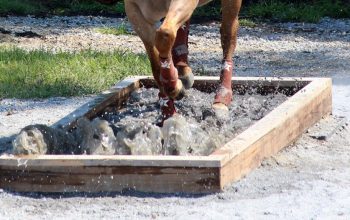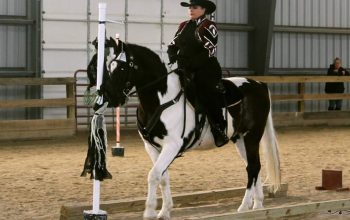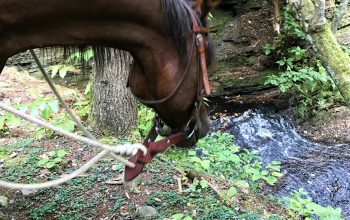Virtual Reality
Learning and showing from the comfort of home
By Lindsey Buhrmann
 Imagine being able to participate in educational programs and horse shows without ever leaving your property. Thanks to North American Western Dressage (NAWD) and its sister organization for traditional dressage enthusiasts called Dressage on a Dime (DOD), these things – and more – are possible.
Imagine being able to participate in educational programs and horse shows without ever leaving your property. Thanks to North American Western Dressage (NAWD) and its sister organization for traditional dressage enthusiasts called Dressage on a Dime (DOD), these things – and more – are possible.
NAWD and DOD offer casual, fun and affordable ways to learn horsemanship skills through virtual horse shows, a vibrant online community, live events and clinics at host barns across the United States and Canada, as well as through a competitive and educational year-end award program called TRAX: Total Recognition for Accomplishing eXcellence.
 The organization was established seven years ago by Jen Johnson of Minnesota. “I was inspired to get involved with Western dressage in 2010 before it was even a discipline by a photograph of a horse doing a lovely haunches-in down the long side of a dressage arena in a Western saddle,” Johnson said. “I called up my sister, Greta Liubakka, and said, ‘We need to do this!’ I am a Western rider but had taken a few dressage lessons but felt more comfortable in my Western saddle.”
The organization was established seven years ago by Jen Johnson of Minnesota. “I was inspired to get involved with Western dressage in 2010 before it was even a discipline by a photograph of a horse doing a lovely haunches-in down the long side of a dressage arena in a Western saddle,” Johnson said. “I called up my sister, Greta Liubakka, and said, ‘We need to do this!’ I am a Western rider but had taken a few dressage lessons but felt more comfortable in my Western saddle.”
NAWD has since evolved from a regional club to a national organization that includes a variety of disciplines. “We focus on helping riders from all backgrounds learn how the classical principles found in dressage can help every horse carry itself better, which improves health and long-term soundness,” Johnson said. “Our programs now include groundwork, trail and ranch horse. We also invite traditional dressage riders to participate and have removed some of the constraints by allowing more options for tack choices, such as bitless bridles.”
Virtual Horse Shows: How They Work
 NAWD and DOD host virtual horse shows throughout the year, allowing equestrians to test their skills and compete for awards from home. To participate, competitors select the tests they will perform at www.nawdhorse.org.
NAWD and DOD host virtual horse shows throughout the year, allowing equestrians to test their skills and compete for awards from home. To participate, competitors select the tests they will perform at www.nawdhorse.org.
Then, during a set time period (usually about a week), the competitor is filmed by a friend or family member from “C,” a set point in an arena so the judge can view each entry from the same vantage point.
The competitor then posts the video on YouTube and submits a link to NAWD for review and placement. When judging is complete, thorough score sheets and awards are returned to competitors. For those not wanting to compete, NAWD and DOD also offer virtual coaching with detailed analysis and tips.
A big benefit is getting feedback from certified judges at a fraction of the cost of participating in live competitions. The average cost of a virtual NAWD or DOD entry is around $30; a day at a live non-NAWD/DOD competition can easily cost several hundred dollars.
“We pride ourselves on welfare of the horse and educating our riders and competitors,” Coeli Netsky, a NAWD judge based in New Jersey, said. “We spend a great deal of time on every test we judge and give lots of feedback and comments to help riders achieve their goals.”
NAWD’s first priority has always been equine welfare, explains Johnson. “In 2016, we began giving a mandatory score of ‘4’ out of ‘10’ for riders who perform with their horse’s nose behind the vertical and developed an variety a horse has in his life and routines – as long as all put the horse’s health and soundness first – the more objective judging system that provides more information to riders about the meanings of their scores,” she said. “We strive to simplify the language of dressage without minimizing its importance.”
“NAWD has benefited my clients by giving them a broader stage on which to have fun with their horses. Many of my clients are English riders, dressage mostly, but they are also curious about all things ‘horse,’ so when NAWD, through its humane standards and rules, put the horse’s welfare first, some of these ladies have ‘crossed over’ and enjoyed riding in Western dressage! It is my experience that the more variety a horse has in his life and routines – as long as all put the horse’s health and soundness first – the more benefit to the horse because it makes the horse’s world more interesting,” Donna Snyder-Smith, a professional from Oregon, said.
Stacey Gorman, an exhibitor from Wisconsin, has competed in virtual shows with NAWD for several years.
“I have greatly benefited from the judges’ reviews and comments. They want to help and encourage. I feel I’ve improved in many areas that I wouldn’t have on my own,” she said.
Jean Thomas, another participant from Wisconsin, exhibits horses through NAWD programs, too.
“I have a better relationship and understanding with my horse than I ever had,” Thomas said. “The virtual shows are a great way to see where you need improvement and what you are doing correctly. I am so glad to be a part of this group, and it also makes you want to improve your relationship with your horse.”
Education Matters
 Johnson says education and progressive training are at the heart of NAWD.
Johnson says education and progressive training are at the heart of NAWD.
“We start from the ground up. Our ‘Six Feet on the Ground’ program applies the training scale from the ground to help you develop a solid foundation for your horsemanship, and our new NAWD Trail program puts your Western dressage knowledge to the test with practical obstacles and a judging system based on the classical training scale,” Johnson said.
“NAWD has benefited my younger horse and I with Six Feet on the Ground,” said Crystal Short of Wisconsin. “With my older horse, it benefits us to just keep up on all the movement to help him stay relaxed, limber; we really love having something to do to keep active. I love the comments given so you know how to improve, and the praise when you do a good job.”
________________________________
Lindsey Buhrmann is a member of North American Western Dressage and the year-end 2016 Amateur Champion for its groundwork program, Six Feet on the Ground.
Learn more about NAWD
Website >
Facebook >




